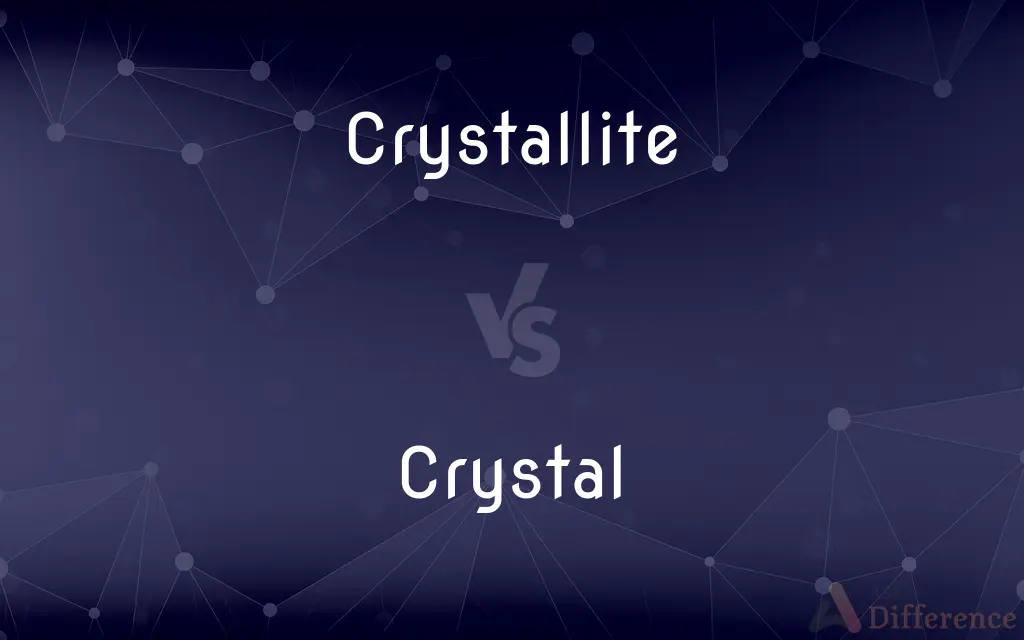Crystallite vs. Crystal — What's the Difference?
Edited by Tayyaba Rehman — By Fiza Rafique — Updated on February 27, 2024

Difference Between Crystallite and Crystal
Table of Contents
ADVERTISEMENT
Key Differences
Crystallites are microscopic, individual regions within a polycrystalline material where the atoms are arranged in a crystallographic lattice that is continuous and defect-free. These are often found within larger structures and are not fully extended throughout the material. In contrast, a crystal is a larger, often visible solid where the entire structure is a continuous, repeating lattice of atoms or molecules. This distinction highlights the scale and continuity of atomic arrangement.
The formation of crystallites occurs during the process of crystallization within materials, often as a result of cooling from a liquid or a gas. These crystallites can grow and merge but are typically separated by grain boundaries. Crystals, on the other hand, form when the conditions allow for a continuous lattice to extend without interruption, often requiring more uniform conditions of formation, such as slow cooling or evaporation of a solution.
The properties of a material containing crystallites, such as mechanical strength or optical characteristics, can differ significantly from those of a single crystal. This is because the presence of grain boundaries and the size of the crystallites can influence the material's overall behavior. Single crystals, with their uniform lattice, tend to have more predictable and homogeneous properties.
Materials with crystallites are often used where a combination of properties is desired, such as in metals for construction, which benefit from the strength provided by the grain structure. Single crystals are sought after in applications requiring high precision and uniformity, such as in semiconductor wafers, where electronic properties must be consistent.
The study and characterization of crystallites involve techniques such as X-ray diffraction and electron microscopy, which can reveal the size and orientation of these microscopic structures. Understanding crystals involves similar techniques but focuses on identifying the lattice structure and defects that affect the material's properties on a larger scale.
ADVERTISEMENT
Comparison Chart
Definition
A small, coherent crystal structure within a material, often microscopic.
A solid material whose entire structure consists of a continuous, ordered lattice.
Scale
Microscopic, can vary in size but does not extend through the entire material.
Can range from microscopic to macroscopic, extending throughout the entire material.
Formation
Occurs during crystallization in polycrystalline materials, often separated by grain boundaries.
Requires uniform conditions allowing for a continuous lattice to form without interruption.
Properties
Properties can vary due to the influence of grain boundaries and crystallite size.
Tends to have uniform and predictable properties due to the continuous lattice.
Applications
Used in materials where a balance of properties is needed, such as metals for construction.
Preferred in applications requiring high precision and uniformity, like semiconductor wafers.
Compare with Definitions
Crystallite
A small, coherent crystal structure within a larger material.
The metal's toughness was attributed to the dense arrangement of crystallites within its structure.
Crystal
A solid whose surface regularity reflects its internal symmetry.
The crystal's facets reflected light, creating a brilliant sparkle.
Crystallite
The basic building blocks of a polycrystalline substance.
Analyzing the crystallites gives insight into the material's overall properties.
Crystal
A single piece of material where atoms are arranged in a continuous lattice.
Scientists grew a large crystal in the lab for the experiment.
Crystallite
A microscopic crystal forming part of a polycrystalline solid.
Crystallites in the ceramic improved its thermal stability.
Crystal
The form taken by substances when atoms are highly ordered.
Salt forms cubic crystals when it crystallizes from water.
Crystallite
A phase within a solid where atoms are in a repeating arrangement.
The crystallites were visible under the high-powered microscope.
Crystal
Material used in electronic devices for its precise atomic arrangement.
The silicon crystal is essential for manufacturing computer chips.
Crystallite
Units of crystalline material separated by grain boundaries.
The alloy's strength is influenced by the size and distribution of its crystallites.
Crystal
A solid material with a regular, repeating atomic structure extending in all directions.
The quartz crystal showcased a perfect hexagonal shape.
Crystallite
A crystallite is a small or even microscopic crystal which forms, for example, during the cooling of many materials. Crystallites are also referred to as grains.
Crystal
A crystal or crystalline solid is a solid material whose constituents (such as atoms, molecules, or ions) are arranged in a highly ordered microscopic structure, forming a crystal lattice that extends in all directions. In addition, macroscopic single crystals are usually identifiable by their geometrical shape, consisting of flat faces with specific, characteristic orientations.
Crystal
A solid formed by the solidification of a chemical and having a highly regular atomic structure
Crystal
A crystalline element used as a component in various electronic devices
Crystal
A rock formed by the solidification of a substance; has regularly repeating internal structure; external plane faces
Common Curiosities
What is a crystallite?
A crystallite is a small, coherent crystal structure within a material, often microscopic and part of a larger polycrystalline solid.
What distinguishes a crystallite from a crystal?
The main distinction is scale and continuity; crystallites are microscopic and part of larger materials, while crystals are continuous, ordered lattices that can be macroscopic.
What defines a crystal?
A crystal is defined as a solid material whose atoms or molecules are arranged in a highly ordered, repeating lattice that extends in all directions.
Can a material contain both crystals and crystallites?
Typically, materials are classified as either polycrystalline, containing crystallites, or single-crystal, but composite materials can have regions of both.
What techniques are used to study crystallites?
Techniques like X-ray diffraction and electron microscopy are used to study the size, orientation, and distribution of crystallites within materials.
How are crystals used in technology?
Crystals are used in various technological applications, including electronics (semiconductor wafers) and optics (lasers), due to their uniform properties.
How do crystallites form?
Crystallites form during the crystallization process in materials, as atoms arrange themselves into a crystallographic lattice, often due to cooling from a liquid or a gas.
Why are crystallites important in materials science?
Crystallites influence the physical properties of materials, such as mechanical strength and thermal stability, due to their size and the presence of grain boundaries.
Do crystallites affect the properties of metals?
Yes, the size and distribution of crystallites within metals can significantly affect their strength, ductility, and resistance to corrosion.
Can the presence of crystallites be beneficial?
Yes, in many materials, the presence of crystallites can enhance properties like strength, durability, and resistance to thermal shock.
How is crystal growth controlled in the lab?
Crystal growth is controlled by adjusting conditions such as temperature, solute concentration, and evaporation rate to promote uniform lattice formation.
What is the significance of grain boundaries in crystallites?
Grain boundaries in crystallites can act as barriers to dislocation movement, affecting the material's mechanical properties.
What role do crystals play in optical applications?
Crystals are crucial in optical applications for their ability to diffract light, making them essential in lasers, lenses, and other optical devices.
Share Your Discovery

Previous Comparison
Paycheque vs. Paycheck
Next Comparison
Aerial vs. OrthophotoAuthor Spotlight
Written by
Fiza RafiqueFiza Rafique is a skilled content writer at AskDifference.com, where she meticulously refines and enhances written pieces. Drawing from her vast editorial expertise, Fiza ensures clarity, accuracy, and precision in every article. Passionate about language, she continually seeks to elevate the quality of content for readers worldwide.
Edited by
Tayyaba RehmanTayyaba Rehman is a distinguished writer, currently serving as a primary contributor to askdifference.com. As a researcher in semantics and etymology, Tayyaba's passion for the complexity of languages and their distinctions has found a perfect home on the platform. Tayyaba delves into the intricacies of language, distinguishing between commonly confused words and phrases, thereby providing clarity for readers worldwide.















































